
The Buthidae are the largest family of scorpions, containing about 100 genera and 1339 species as of 2022. A few very large genera are known, but a high number of species-poor or monotypic ones also exist. New taxa are being described at a rate of several new species per year. They have a [cosmopolitan] distribution throughout tropical and subtropical environments worldwide. Together with four other families, the Buthidae make up the superfamily Buthoidea. The family was established by Carl Ludwig Koch in 1837.
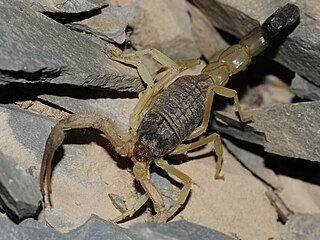
Hottentotta is a genus of scorpions of the family Buthidae. It is distributed widely across Africa, except for most of the Sahara desert. Species in the genus also occur in the Middle East, the Arabian Peninsula, southeastern Turkey, Iraq, Iran, Afghanistan, Pakistan, India, Nepal, Cape Verde Islands, and Sri Lanka (introduced).
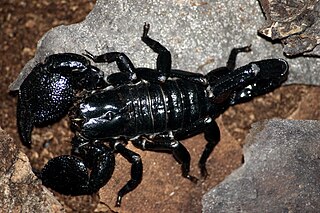
Pandinus is a genus of large scorpions belonging to the family Scorpionidae. It contains one of the most popular pet scorpions, the emperor scorpion . The genus is distributed across tropical Africa.
Babycurus-toxin 1 (BcTx1) is a component of the venom of the east African scorpion Babycurus centrurimorphus. This toxin modifies both the activation and the inactivation properties of insect sodium channels.

Mesobuthus eupeus is a polymorphic scorpion species belonging to the well-known family Buthidae. Commonly known as the lesser Asian scorpion or the mottled scorpion. It is thought to be the most widely dispersed species of the genus Mesobuthus, perhaps even of the family Buthidae.
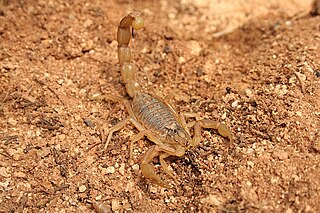
Buthus is a genus of scorpion belonging and being eponymous to the family Buthidae. It is distributed widely across northern Africa, including Morocco, Mauritania, Algeria, Tunisia, Libya, Egypt, Senegal, Guinea-Bissau, Nigeria, Sudan, Somalia, Ethiopia, Djibouti, as well as the Middle East, including Israel, Palestine, Jordan, Lebanon, Iraq, Yemen, and possibly Saudi Arabia and southern Turkey. Its European range includes the Iberian Peninsula, southern France, and Cyprus.

Isometrus maculatus, commonly as the lesser brown scorpion, is a species of scorpion in the family Buthidae. Its distribution is pantropical; it is an introduced species in Hawaii.
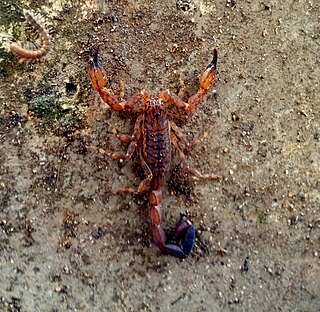
Reddyanus besucheti is a species of scorpion in the family Buthidae endemic to Sri Lanka.
Reddyanus loebli is a species of scorpion in the family Buthidae.

Babycurus is a genus of scorpions of the family Buthidae.
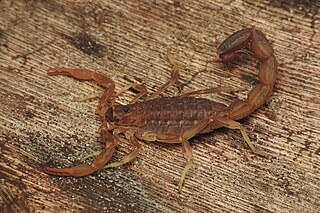
Lychas srilankensis is a species of scorpion in the family Buthidae. It is endemic to Sri Lanka.
Ananteris nairae is a scorpion species found in Brazilian Amazonia. The species has the most western distribution of the species in Ananteris. The specific epithet refers to Nair Otaviano Aguiar.

Hottentotta conspersus, the Sesriem Scorpion, is a species of scorpion of the family Buthidae.

Leiurus abdullahbayrami is a species of scorpion in the family Buthidae. Its venom is highly toxic to humans, but can be used in medical development.
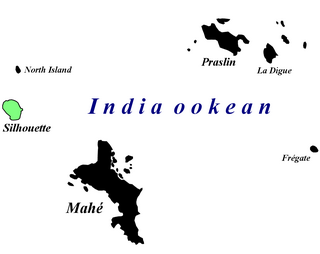
Afrolychas braueri, commonly known as the Seychelles forest scorpion, is a species of scorpion in the family Buthidae. It is currently thought to survive only on Silhouette Island, Seychelles, although the species was historically found on two additional Seychellois islands. This scorpion lives in leaf litter in forests that are largely unaffected by invasive plant species. It is a small yellowish-brown scorpion with three prominent keels on the dorsal surface of its mesosoma, which distinguishes it from other scorpions. While not much is known about the Seychelles forest scorpion's ecology due to the paucity of sightings, it is known to rely solely on its venom to capture its prey and defend its young. Its venom is not dangerous to humans.
Isometrus kovariki is a species of scorpion in the family Buthidae. It was identified in and currently found only in a small region of Southern Karnataka, in an Acacia auriculiformis plantation, and it is closely related to Isometrus thurstoni, a species of scorpion endemic to the Western Ghats region of India.

Reddyanus is a genus of buthid scorpions native to Oriental region from India, Sri Lanka, China: Tibet, to Melanesia. The genus was previously described as a subgenus of Isometrus.
Reddyanus ceylonensis is a species of scorpion in the family Buthidae endemic to Sri Lanka.
Reddyanus jayarathnei is a species of scorpion in the family Buthidae endemic to Sri Lanka.
Reddyanus ranawanai is a species of scorpion in the family Buthidae endemic to Sri Lanka.













